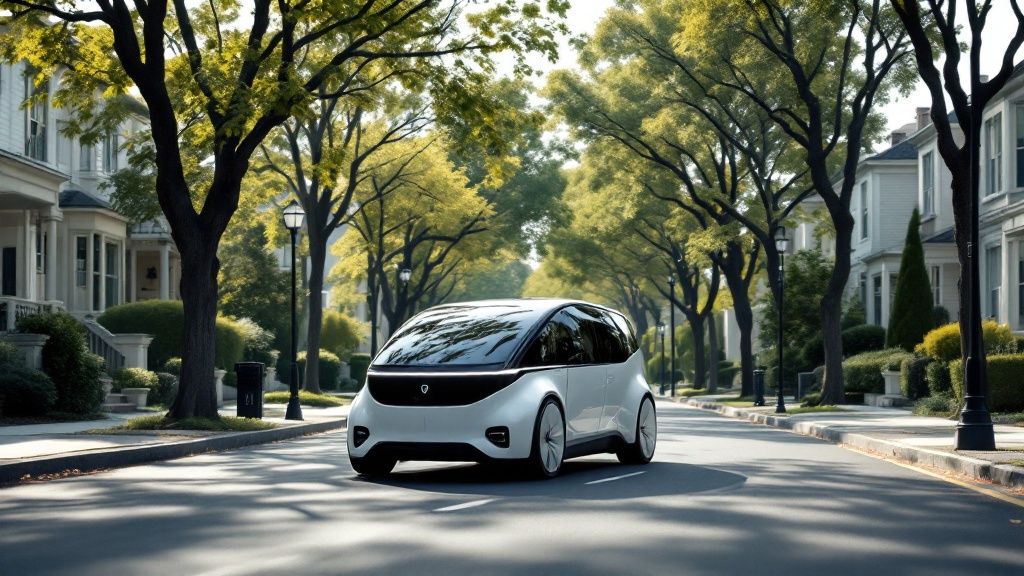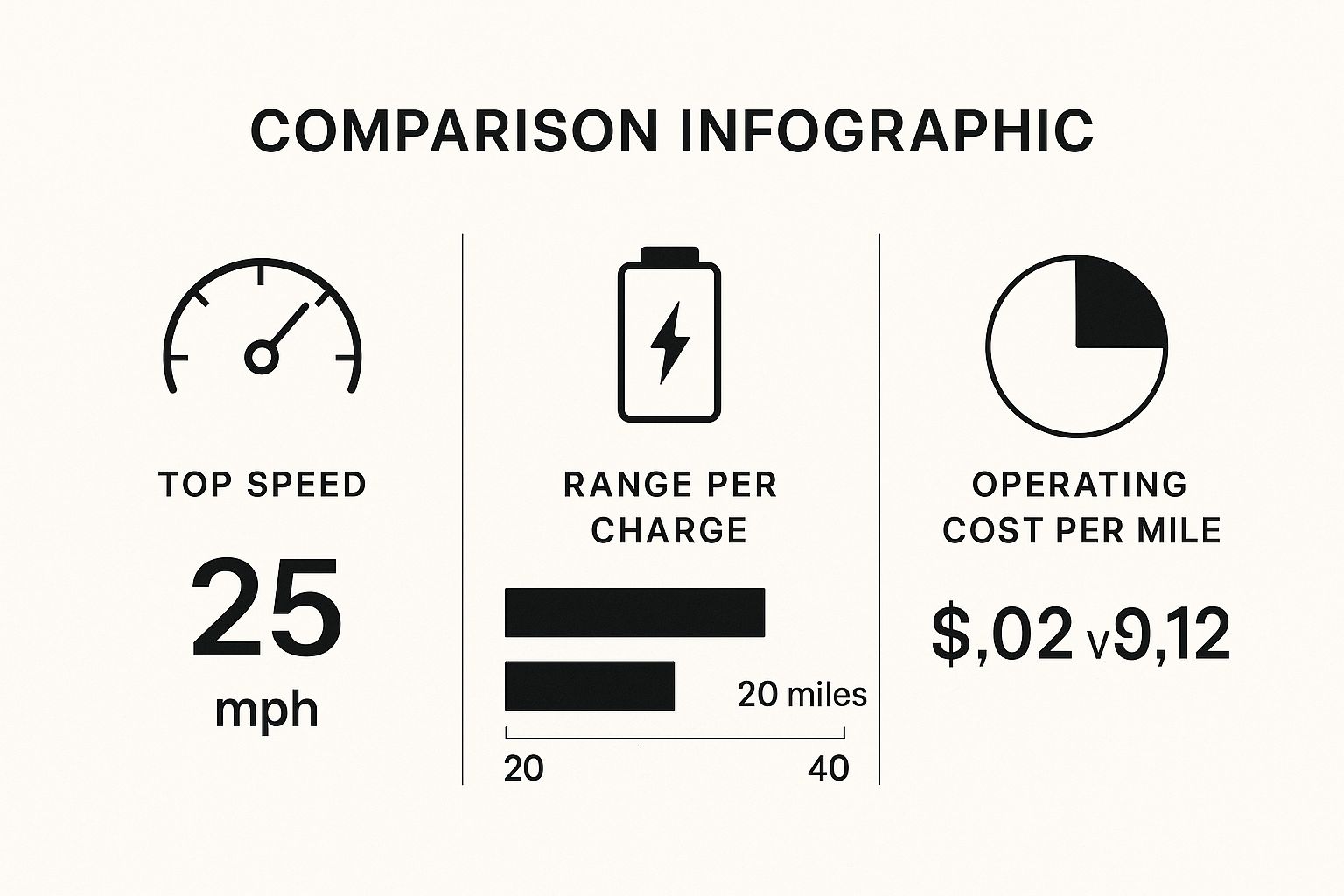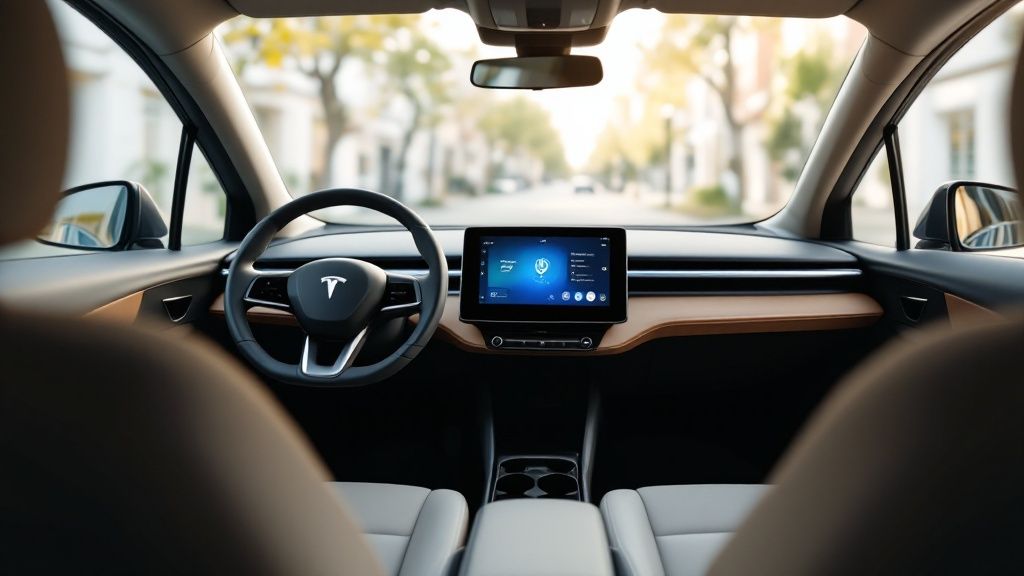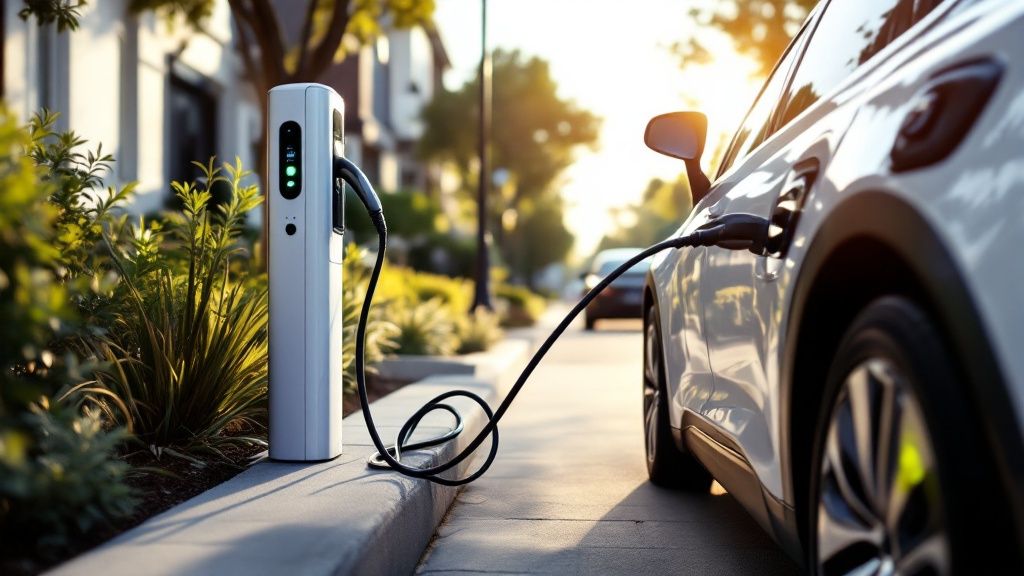A Neighborhood Electric Vehicle, or NEV, is a compact, street-legal electric car built for short trips around your local community. You might also hear them called Low-Speed Vehicles (LSVs). Think of them as more than just a souped-up golf cart; they are a distinct, federally regulated class of vehicle designed for safety and practicality on roads with lower speed limits.
Getting to Know the Neighborhood Electric Vehicle

Picture a vehicle that fits perfectly with the pace of community life—that's the essence of an NEV. It elegantly fills the niche between your primary car and a simple golf cart, giving you a green, convenient option for those quick errands and local jaunts.
While a standard car is built to handle highways, an NEV is perfectly at home in places like gated communities, college campuses, and resort areas. It's purpose-built for these environments.
It's no surprise these vehicles are gaining traction as more people look for smarter, more sustainable ways to get around. The global NEV market is booming, valued at USD 3.59 billion in 2024 and projected to climb to USD 6.23 billion by 2033. This growth signals a real shift in how we think about efficient, local travel.
What Makes an NEV an NEV?
To earn the legal classification of an NEV or LSV, a vehicle can't just look the part—it has to meet specific federal standards. These rules are what officially separate a true, road-ready NEV from a modified golf cart. You can dive deeper into these distinctions in our guide on what defines a Low-Speed Vehicle.
At its core, an NEV is all about balancing everyday utility with safety for a specific environment. It's designed for community roads, not highways, making it the perfect "second car" for all your local trips.
To make things simple, here’s a quick breakdown of the key characteristics that define a Neighborhood Electric Vehicle.
Neighborhood Electric Vehicle at a Glance
| Characteristic | Typical Specification |
|---|---|
| Top Speed | Legally capped at 25 mph (40 km/h). |
| Street Legality | Must have DOT-approved safety features. |
| Road Access | Permitted on roads with speed limits of 35 mph or less. |
| Power Source | 100% electric, powered by a rechargeable battery. |
| Passenger Capacity | Typically carries 2 to 6 passengers. |
| Primary Use | Short-distance travel within a local area. |
These specifications ensure NEVs are safe, compliant, and perfectly matched to their job: providing a quiet, efficient, and enjoyable way to get around your neighborhood.
How NEVs Differ From Standard Golf Carts
At first glance, you might see a Neighborhood Electric Vehicle (NEV) and think, "That's just a fancy golf cart." It's an easy mistake to make, but the reality is they're worlds apart. The difference isn't just about looks; it's a fundamental distinction rooted in federal law, safety equipment, and where you can legally drive them.
Simply put, one is a regulated motor vehicle, while the other is an off-road utility cart.
A standard golf cart is built for a very specific job: cruising around the gentle hills of a golf course or the quiet, private lanes of a master-planned community. They're not designed for public roads and lack the essential safety gear to be there.
An NEV, on the other hand, is engineered from the ground up to meet strict federal safety standards. This is what officially classifies it as a Low-Speed Vehicle (LSV) and makes it completely ready for the road.
The Street-Legal Difference
For a vehicle to earn the NEV classification, it has to come equipped with a specific set of Department of Transportation (DOT) approved safety features. These aren't optional extras you can add on later; they are factory-installed, mandatory components that make the vehicle safe to share the road with cars.
These legally required features include:
- Headlights and Taillights for clear visibility, day or night.
- Brake Lights and Turn Signals to let other drivers know what you're doing.
- DOT-Approved Windshields to protect you from road debris.
- Seat Belts at every seat to keep passengers secure.
- Rear-View and Side-View Mirrors for complete awareness of your surroundings.
- A Vehicle Identification Number (VIN), just like any car or truck.
Here’s a good way to think about it: a golf cart is to a bicycle what an NEV is to a moped. While they look similar, one has the legal standing and safety equipment required for public roads, while the other is strictly limited to controlled, off-road environments.
The presence of a VIN and a full suite of DOT-mandated safety features is the bright line separating a road-legal NEV from an off-road golf cart. It’s what makes one a registered vehicle and the other a piece of recreational equipment.
This visual breakdown offers a quick look at an NEV's top speed, range, and operating costs, really showing off its practical side for everyday trips.

As you can see, NEVs aren't just faster—they're also a remarkably cost-effective way to get around town, mile for mile.
NEV vs Standard Golf Cart a Head-to-Head Comparison
To really nail down what a neighborhood electric vehicle is, nothing beats a direct comparison. While both give you quiet, electric transportation, their purpose, legal status, and built-in equipment put them in completely different leagues.
This table cuts through the noise and puts those key differences into sharp focus.
| Feature | Neighborhood Electric Vehicle (NEV/LSV) | Standard Golf Cart |
|---|---|---|
| Legal Status | Street-legal on roads with posted speed limits of 35 mph or less. | Generally not street-legal; restricted to private property or golf courses. |
| Top Speed | Federally capped at 25 mph. | Typically 12-15 mph. |
| Required Safety Gear | Full suite including seat belts, lights, mirrors, and a VIN. | Minimal; may have basic lights but lacks most DOT-mandated gear. |
| Registration & Insurance | Requires state registration, a license plate, and insurance. | Does not require registration or standard auto insurance. |
| Primary Use | Short-distance, on-road transportation within a community. | Off-road recreation and utility on private land. |
The takeaway is clear. An NEV is a legitimate, road-ready vehicle designed for local transit, while a golf cart is best left on the back nine or private paths.
Navigating NEV Laws and Local Regulations

Getting behind the wheel of a Neighborhood Electric Vehicle (NEV) is refreshingly simple, but once you hit public roads, you'll need to know a few rules of the road. The legal side of things is layered, starting with a clear federal definition that then filters down into state and local specifics. Getting a handle on this framework is all it takes to drive your NEV with total confidence.
It all starts at the national level, where the federal government sets the baseline. NEVs are officially classified as Low-Speed Vehicles (LSVs). This isn't just a name; it comes with a strict set of requirements, including a top speed that can't go over 25 mph on a flat, paved road and the inclusion of all those safety features we talked about earlier.
This federal standard creates a consistent definition for what a street-legal NEV is, no matter where you live. But that's just the first piece of the puzzle.
State and City Rules
While the feds define the vehicle itself, it’s your state and local governments that decide where and how you can actually drive it. This is where things get a bit more specific to your own neighborhood.
The most common rule you'll run into deals with road access. Most states give NEVs the green light on public roads with a posted speed limit of 35 mph or less. The idea is simple: it keeps the speed difference between your NEV and the cars around you from getting too big, which makes things safer for everybody. You generally won't be allowed to take your NEV on a 45 mph road, for example.
Beyond just where you can drive, states also handle all the usual paperwork that comes with owning any vehicle.
You can think of it as a three-tiered system. The federal government says, "This is what an NEV is." Your state government says, "Here’s what you need to do to drive it on our roads." And finally, your city or town might add, "And here are the specific streets where you can—and can't—go."
Driver Requirements and Paperwork
Because an NEV is a registered motor vehicle, you have the same basic responsibilities as any other driver. This isn't like jumping on an e-bike; you're operating a licensed vehicle on public streets.
To legally drive your NEV, you're almost certainly going to need:
- A Valid Driver's License: No surprises here. If you can drive a car, you can drive an NEV.
- Vehicle Registration: Just like a car, your NEV needs to be registered with your state's DMV and have its own license plate.
- Proof of Insurance: This one is non-negotiable. It’s absolutely mandatory.
Insurance is crucial because it protects you and everyone else if there's an accident. Policies for these vehicles are often specialized. You can find out more about getting the right low-speed vehicle insurance to make sure you’re fully covered.
Before you start cruising, it's always a smart move to check with your local DMV and city hall. A quick look at their websites can clear up any specific rules for your town or planned community, giving you total peace of mind every time you head out.
The Practical Benefits of Owning an NEV

So, what's behind the growing buzz around neighborhood electric vehicles? It really boils down to a powerful mix of being good to the planet, saving a surprising amount of money, and simply enjoying a more connected community life. These aren't just scaled-down cars; they offer real-world advantages that fit perfectly with how many of us live today.
The most obvious win is for the environment. An NEV has zero tailpipe emissions. Think about that for a second. Every single trip to the grocery store or the local park becomes a small act that contributes to cleaner air right where you live. It’s a direct, measurable way to shrink your carbon footprint without upending your life.
This move toward local, green transport isn't just a small trend, either. It’s part of a much bigger picture. The global NEV market is expected to expand at a compound annual growth rate of roughly 15.5% between 2025 and 2032. This surge is fueled by a collective desire for sustainable living and smarter ways to deal with urban pollution. If you're curious about the numbers, you can learn about the market's projected growth and see just how fast things are changing.
Substantial Financial Savings
Beyond doing good for the planet, the financial argument for an NEV is incredibly strong. Just imagine never having to swing by the gas station again. You simply plug in your vehicle at home, and the cost of electricity is just a tiny fraction of what you'd pay for a tank of gas. The savings start immediately and just keep adding up.
But it’s not just about fuel. NEVs are mechanically simple compared to a gas-powered car with all its complex engine parts.
- No oil changes: Electric motors don't need oil, so that's one less thing to worry about.
- No spark plugs or filters: Forget about those routine engine tune-up expenses.
- Reduced brake wear: Many NEVs use regenerative braking, which not only recharges the battery a bit but also means your brake pads last much longer.
All of this adds up to significantly lower maintenance costs over the years.
Owning an NEV simplifies your budget by replacing unpredictable gas prices and frequent maintenance costs with a low, stable electricity bill and minimal upkeep.
An Enhanced Community Lifestyle
The perks of an NEV go way beyond your bank account; they genuinely improve your day-to-day life. Because they run almost silently, you can head out for an early-morning gym session or come home late without waking up the whole neighborhood. It helps create a quieter, more peaceful atmosphere for everyone.
Their smaller size is another huge plus. Parking becomes a breeze, as NEVs can tuck into spots that are impossible for a regular car. This incredible convenience makes you more likely to pop out for quick errands or visit a neighbor, fostering that friendly, walkable community feel that so many of us are looking for.
Where NEVs Really Come Into Their Own
Okay, let's move past the specs and regulations for a minute. The real magic of a neighborhood electric vehicle isn't on a spec sheet—it's how it fits perfectly into certain parts of our daily lives. These vehicles weren't built to do everything, but they were built to do a few things exceptionally well.
Picture a sprawling, master-planned community. Instead of firing up the SUV for a quick trip to the community pool or to grab the mail, residents just hop into their NEV. It’s the perfect tool for those little errands, cutting down on noise, traffic, and fumes right where people live.
The same idea applies to a big college or corporate campus. Suddenly, getting from one side to the other is no big deal. Students and staff can zip between buildings without the headache of parking a full-sized car, and the quiet, emission-free ride helps keep the campus environment calm and pleasant.
From Resorts to Business Parks
The business world has caught on, too, especially in hospitality. Think about those big, beautiful resorts. They use fleets of NEVs to shuttle guests and their luggage around the property. It turns a simple ride from the lobby to a room into a quiet, open-air experience that feels like part of the vacation.
But it’s not just about guest experience. Businesses are finding all sorts of practical uses for NEVs. They're a fantastic solution for last-mile delivery in busy city centers. Maintenance crews also love them for hauling gear across large facilities without the expense and hassle of a big truck.
An NEV thrives in places where convenience, low running costs, and local-first travel are what matter most. It’s the king of controlled environments, taking the place of bigger, clunkier vehicles for all those short, frequent trips.
This isn't just a niche trend. The commercial use of these low-speed electric vehicles is a huge factor in the market's expansion. In fact, this corner of the EV industry was valued at roughly USD 9.18 billion in 2024 and is on track to reach an incredible USD 36.52 billion by 2034. If you're curious, you can explore more data on this impressive growth in the low-speed EV market.
So, where are you most likely to see an NEV making a difference?
- Gated and Retirement Communities: The go-to vehicle for daily errands and visiting friends.
- University and College Campuses: Perfect for getting students and staff across campus.
- Large Industrial or Corporate Parks: A smart way to move people and supplies between buildings.
- Resorts and Vacation Properties: Ideal for guest shuttles and staff getting around.
- Local Delivery Services: A green and efficient way to transport goods around town.
Choosing the Right NEV for Your Lifestyle
Picking the perfect Neighborhood Electric Vehicle isn't just about color or style. It’s really about matching the vehicle to your actual, day-to-day life. If you get it right, your new NEV will feel like a natural extension of your routine.
So, where do you start? I always tell people to begin with the heart of the vehicle: the battery.
This is a big one. You'll typically be choosing between traditional lead-acid batteries and the more modern lithium-ion options. Lead-acid batteries will save you some money upfront, but they're heavy, need regular upkeep, and won't last as long.
On the other hand, lithium-ion batteries are a game-changer. They're lighter, last significantly longer, and deliver consistent power without the maintenance headaches. It's a bigger investment initially, but it pays off in the long run.
Matching the NEV to Your Needs
Once you’ve thought about the power source, think about what—and who—you'll be bringing along for the ride.
Are you usually flying solo or just with a partner? A two-seater might be perfect. Or do you need room for the whole family or a group of friends? In that case, you'll want to look at four or even six-seater models.
And don't forget about cargo. If you're planning on hauling gardening supplies, sports gear, or groceries, you need to look at the payload capacity. That number tells you the total weight the vehicle can safely handle, and it’s crucial for making sure the NEV can do the work you need it to do.
Beyond the core specs, think about the little things that make a big difference in your specific climate and daily use.
- Weather Enclosures: If you live somewhere with unpredictable rain or chilly mornings, a full enclosure with doors is a must-have for staying comfortable and dry.
- Comfort Features: Don't underestimate the power of comfortable seats, well-placed cup holders, and smart storage compartments. They can completely change how much you enjoy your rides.
- Build Quality and Warranty: Always check for a solid frame and quality components. A good manufacturer's warranty isn't just a piece of paper—it's your peace of mind.
A great NEV seamlessly integrates into your lifestyle. The right choice feels less like a purchase and more like a purpose-built solution for your community travel needs.
Ultimately, the best choice balances all these practical needs with your budget and personal taste. For a deeper dive into specific models and how they stack up, take a look at a guide on the best low-speed vehicles. It can really help clarify which features matter most.
Got Questions About NEVs? We've Got Answers.
Even after you get the basic idea of what a neighborhood electric vehicle is, the practical questions start popping up. It's totally normal. Getting clear, simple answers is the best way to figure out if an NEV is truly the right fit for you.
We've pulled together the most common questions we hear, covering everything from road rules to what it really costs to own one. Let's get into it.
So, Can I Drive an NEV on Any Road I Want?
Nope, and this is a big one for safety and legal reasons. NEVs are built for a specific environment: low-speed local streets. In most places, they are only allowed on roads with a posted speed limit of 35 mph or less. You absolutely cannot take them on highways, freeways, or any major road where traffic is moving fast.
Think about it—an NEV tops out at 25 mph. Keeping them off high-speed roads ensures the speed gap between you and other cars stays safe. It's always a good idea to double-check with your local DMV or city hall, as some towns have their own unique rules for certain streets.
Do I Actually Need a Driver's License and Insurance?
Yes, you sure do. The federal government classifies NEVs as Low-Speed Vehicles (LSVs), which puts them in the same category as other motor vehicles when it comes to who can drive them. That means you need a valid driver's license to operate one on public roads.
On top of that, you'll need to get auto insurance and register the vehicle with the DMV. It'll get a real license plate, just like a car. Don't skip these steps! Driving without them can lead to some hefty fines and legal headaches.
Here’s a simple way to think about it: if you're sharing the road with cars, you have to play by the same basic rules. A license, registration, and insurance are the non-negotiables for any street-legal vehicle, including an NEV.
How Far Can I Realistically Go on a Single Charge?
This is a great question, and the answer depends on a few things. On average, you can expect an NEV to go somewhere between 25 and 50 miles on a full battery. What determines if you're on the high or low end of that range?
- Battery Tech: The newer lithium-ion batteries typically give you more mileage and hold a charge better than older lead-acid types.
- The Terrain: Cruising on flat ground is easy on the battery. Tackling a bunch of steep hills? That's going to drain it much faster.
- The Load: The more weight you're carrying—people, groceries, gear—the harder the motor has to work.
- How You Drive: Smooth acceleration and gentle braking will get you the most out of your battery. A lead foot with lots of hard stops and starts will definitely reduce your range.
For most trips around the neighborhood—errands, visiting friends, heading to the community pool—this range is more than enough to get you there and back with juice to spare.
What's the Real Cost of Owning and Maintaining One?
The savings are honestly one of the best parts of owning an NEV. The upfront cost is often less than a new car, but the long-term savings are where you really win. Plugging in at home costs a tiny fraction of what you'd spend at the gas pump.
Maintenance is another huge win. Electric motors are incredibly simple with very few moving parts. That means you can wave goodbye to oil changes, spark plug replacements, and pricey exhaust system repairs. It all adds up to make ownership surprisingly affordable over time.
Ready to see how a smarter, cleaner ride could fit into your life? Solana EV offers a premium lineup of stylish and reliable neighborhood electric vehicles built for your community. Find the perfect model for your daily trips and join the future of local travel. Explore Solana EV's street-legal vehicles today.
